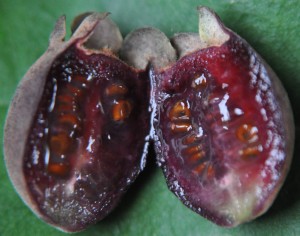Karamunting has many local names, e.g. Masisin in Central Kalimantans, Kemunting in Malaysian and Rose Myrtle or Downy Myrtle in English. Sometimes it is mistaken for the more common Senduduk (Melastoma malabathricum). However, these two berries are not closely related, because Senduduk belongs to Melastomataceae family while Karamunting belongs to Myrtaceae.
 This dark purple fleshy berry is edible, sweet and very juicy with a pleasant aromatic odour. In many parts of Indonesia it usually eat fresh or crush with sugar, water and ice to make a tasty ice juice. According to Burkill, the edible fruit may be made into jams and used in tarts. In Vietnam, the fruits are used to produce a kind of wine called rượu sim. Birds also like to eat the berries and sometimes build nest in its lush bush. The berry is green while young and become purplish red and finally dark purple in color when fully ripe. It has oblong shape, about 0.8-1.2 cm x 1-2 cm, topped by persistant sepals and containing many tiny seeds.
This dark purple fleshy berry is edible, sweet and very juicy with a pleasant aromatic odour. In many parts of Indonesia it usually eat fresh or crush with sugar, water and ice to make a tasty ice juice. According to Burkill, the edible fruit may be made into jams and used in tarts. In Vietnam, the fruits are used to produce a kind of wine called rượu sim. Birds also like to eat the berries and sometimes build nest in its lush bush. The berry is green while young and become purplish red and finally dark purple in color when fully ripe. It has oblong shape, about 0.8-1.2 cm x 1-2 cm, topped by persistant sepals and containing many tiny seeds.
The handsome Karamunting shrub is about 2-4 m tall, usually decorate with abundant beautiful pink flowers. The flowers often become white when faded. The young parts of the plants are whitish and woolly with soft hair all around. The leaves are elliptic or obovate, obtuse, 1 to 2.5 inches long, have three distinct parallel veins, green upside and pale green to white and woolly underneath, arranged opposite.
 The roots and leaves are used to treat diarrhoea, stomachaches and as a tonic after childbirth. The leaves are also used to treat wounds. Tar from its wood is used to blacken eyebrows. The Chinese use the leaves as a pain killer, roots to treat heartburn and seeds in a tonic for digestion, and to treat snake bites. In Indonesia, the leaves are used to treat wounds. In Malaysia, the roots, fruits and leaves are used to treat diarrhoea.
The roots and leaves are used to treat diarrhoea, stomachaches and as a tonic after childbirth. The leaves are also used to treat wounds. Tar from its wood is used to blacken eyebrows. The Chinese use the leaves as a pain killer, roots to treat heartburn and seeds in a tonic for digestion, and to treat snake bites. In Indonesia, the leaves are used to treat wounds. In Malaysia, the roots, fruits and leaves are used to treat diarrhoea.
Rhodomyrtus tomentosa, is native to Southern and Southeast Asia, from India, east to southern China, Taiwan and the Philippines, and south to Malaysia and Indonesia. In Indonesia it can be found grow wildly in Sumatera, Java, Kalimantan, Sulawesi, and other islands. It likes moist and wet forests, bog margins, up to 3000 ft. elevation. The plant is not particular regarding soil, and is readily propagated by means of seeds.
